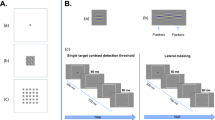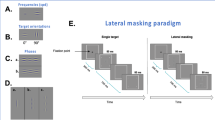Abstract
Homonymous hemianopia (HH) is a visual field defect in which the same side of both eyes is blind. In this paper, we propose an out-of-visual-field information compensation system for HH patients using an optical see-through head-mounted display. In the proposed system, in order to reduce the obstruction in the remaining visual field, indicators are placed at the boundary between the remaining visual field and the defective part to notify the HH patient about the events occurring at the blinded side of the visual field. Two different kinds of indicators, namely brightness-based and flicker-based, are designed to visualize the spatial information of the events. We conducted experiments with simulated HH participants to verify the effectiveness of the proposed system and compare the two designed indicators, as well as an existing method that makes use of the overlay overview window. The experimental results proved that the proposed system can react more intuitively and is faster than the existing method in the part near the central visual field. Moreover, it can alleviate the obstruction problem of the existing method.














Similar content being viewed by others
Data availability
All data generated or analyzed during this study are included in this published article.
References
Gilhotra, J.S., Mitchell, P., Healey, P.R., Cumming, R.G., Currie, J.: Homonymous visual field defects and stroke in an older population. Stroke 33(10), 2417–2420 (2002)
Goodwin, D.: Homonymous hemianopia: challenges and solutions. Dove press. 8. 1919–1927 (2014). https://doi.org/10.2147/OPTH.S59452
Zhao, X., Fujishiro, I., Go, K., Toyoura, M., Kashiwagi, K., Mao, X.: Enhancing visual performance of hemianopia patients with overview window. Comput. Graph. 89, 59–67 (2020)
Ichinose, K., Zhao, X., Fujishiro, I., Toyoura, M., Kashiwagi,K, Go, K., Mao, X.: Visual field loss compensation for homonymous hemianopia patients using edge indicator. In Proceedings of 2020 International Conference on Cyberworlds. 2020. 79–85. (2020)
Duszynski, L.R.: Hemianopsia dichroic mirror device. Am. J. Ophthalmol. 39, 876–878 (1955)
Goodlaw, E.: Review of low vision management of visual field defects. Optometrie Mon. 74, 363–368 (1983)
Peli, E.: Field expansion for homonymous hemianopia by optically induced peripheral exotropia. Optom. Vis. Sci. 77, 453–464 (2000)
Sayed, A.M., Mottaleb, M.A., Kashem, R., Roongpoovapatr, V., Elsawy, A., Mottaleb, M.A., Parrish, R.K., II., Shousha, M.A.: Expansion of peripheral visual field with novel virtual reality digital spectacles. Am. J. Ophthalmol. 210, 125–135 (2020)
Younis, O., Nuaimy, W. A., Taee, M. A. A., Ataby, A. A.: Augmented and virtual reality approaches to help with peripheral vision loss. 14th International Multi-Conference on Systems, Signals & Devices (SSD). (2017)
Fernando, V.A., Peli, E.: Augmented-view for restricted visual field: multiple device implementations. Optom. Vis. Sci. 79, 715–723 (2002)
Bowers, A.R., Luo, G., Rensing, N.M., Peli, E.: Evaluation of a prototype minified augmented-view device for patients with impaired night vision. Ophthalmic Physiol. Opt. 24, 296–312 (2004)
Tseng, H., Liang, R., Chan, V., Chen, B.: LEaD: Utilizing light movement as peripheral visual guidance for scooter navigation. ACM MobileHCI’15. 323–326. (2015).
Niforatos, E., Fedosov, A., Elhart, I., Langheinrich, M.: Augmenting skiers’ peripheral perception. Proceedings of the 2017 ACM International symposium on wearable computers. 114–121. (2017)
Qian, L., Plopski, A., Navab, N., Kazanzides, P.: Restoring the awareness in the occluded visual Field for optical see-through head-mounted displays. IEEE Trans. Visual Comput. Graphics 24, 2936–2946 (2018)
Tyler, C.W.: Analysis of visual modulation sensitivity III meridional variations in peripheral flicker sensitivity. J. Opt. Soc. Am. A. 4, 1612–1619 (1987)
Waldin, N., Waldner, M., Viola, I.: Flicker observer effect: guiding attention through high frequency flicker in Images. Comput. Gr. Forum. 36, 467–476 (2017)
Hart, S.G.: Nasa-task load index (nasa-tlx); 20 years later. Proc. Hum. Factors Ergonomics Soc. Annu. Meet. 50(9), 904–908 (2006). https://doi.org/10.1177/154193120605000909
Song, J.H., McPeek, R.M.: Eye-hand coordination during target selection in a pop-out visual search. J. Neurophysiol. 102, 2681–2692 (2009)
Acknowledgements
We thank the volunteers who took part in the experiments conducted in this study.
Funding
This work is supported by the JSPS Grants-in-Aid for Scientific Research (Grant Nos. 17H00738 and 20K20408).
Author information
Authors and Affiliations
Corresponding author
Ethics declarations
Conflict of interest
The authors declare that they have no known competing financial interests or personal relationships that could have influenced the work reported in this published paper.
Additional information
Publisher's Note
Springer Nature remains neutral with regard to jurisdictional claims in published maps and institutional affiliations.
Rights and permissions
About this article
Cite this article
Ichinose, K., Zhao, X., Fujishiro, I. et al. Enhancing edge indicator for visual field loss compensation for homonymous hemianopia patients. Vis Comput 38, 1263–1273 (2022). https://doi.org/10.1007/s00371-021-02156-9
Accepted:
Published:
Issue Date:
DOI: https://doi.org/10.1007/s00371-021-02156-9




